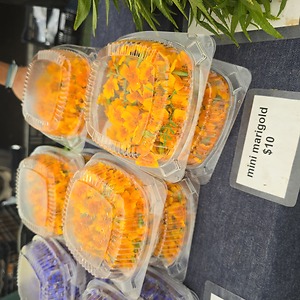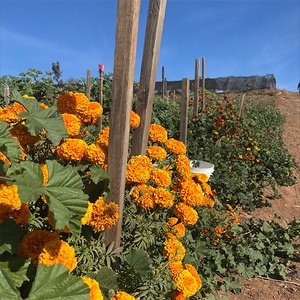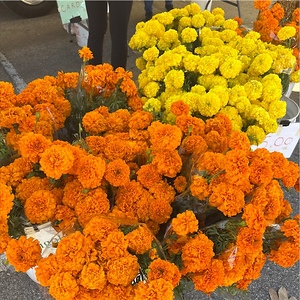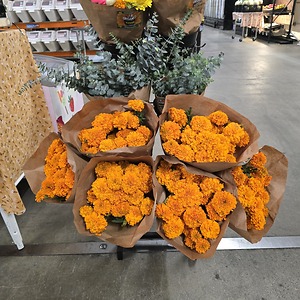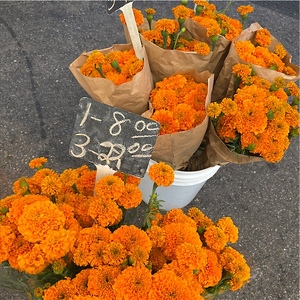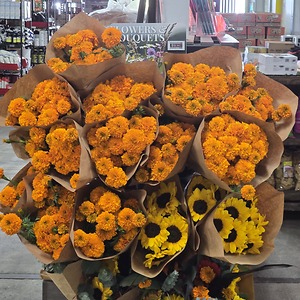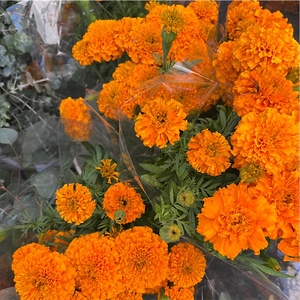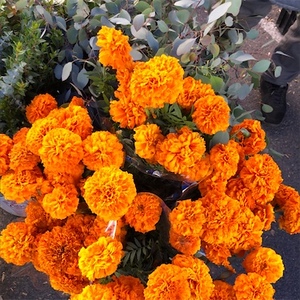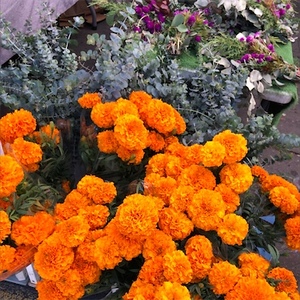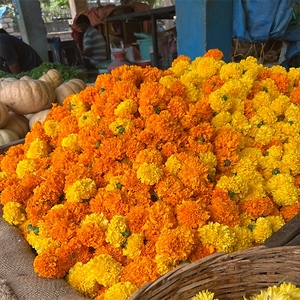

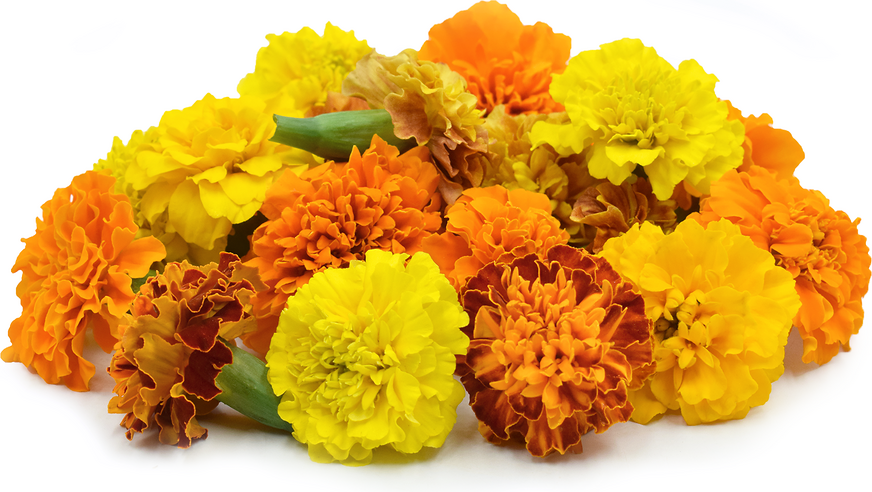
Marigold Flowers
Estimated Inventory, 4 oz : 0
| Fresh Origins | Homepage |
Description/Taste
Marigolds are composite flowers ranging in size from medium to large and measuring approximately 3 to 5 centimeters in diameter. Depending on the variety, the showy blossoms can grow in a pom-pom, anemone, or daisy-shape and are present in a range of yellow, orange, and red hues, sometimes with striped or bicolor petals. Marigolds are comprised of tiny florets surrounded by many layers of delicate, ruffled petals and a thick hollow stem with fernlike leaves. The flowers have a pungent, sharp, and musky aroma that can be considered unpleasant. The flowers also have a robust citrusy flavor with a peppery and bitter finish.
Seasons/Availability
Marigold flowers are in season from late spring through summer in cold climates and through late fall in warmer climates.
Current Facts
Marigolds is a generalized term for over 50 varieties of flowering shrubs in the Tagetes family. The flowers bloom at the end of a long hollow stem surrounded by soft, fern-like leaves. The vibrant blossoms range in shape, size, and color depending on the variety. The two most common varieties are the French marigold, Tagetes patula, and the African marigold, Tagetes erecta. French marigolds are more compact, with few petal layers and a flatter appearance. African marigolds are much larger, reaching up to ten centimeters in diameter with a full-rounded pom-pom shape. Marigolds grow relatively easily in warm and temperate climates. They have a strong, pungent aroma that naturally repels insects, making them an ideal companion plant for vegetable gardens. The plants are native to Mexico and Central America and have been used in rituals in these regions for thousands of years. The plants were sacred to ancient cultures like the Mayans and Aztecs and are still an important part of the Mexican holiday, Dia de Los Muertos. Marigolds can be given as a symbol of happiness, joy, passion, and positive energy. The flower can elevate the color, texture, dimension, and flavor of many different culinary applications. Outside of their culinary uses, the flowers are used medicinally as a yellow dye and in poultry feed to increase the yellow pigment in egg yolks.
Nutritional Value
Marigold flowers are rich in carotene, iodine, and manganese, a trace mineral that promotes cell regeneration and hormone production. The flowers also contain lutein, a carotenoid important for maintaining eye health, and glycoproteins and nucleoproteins, two compounds that support skin healing. Marigold florets contain antifungal, antibacterial, and anti-inflammatory properties that have been shown to be effective at treating sore throat and mouth sores, especially when added to tea and gargled.
Applications
Marigolds are best suited as an edible accent, added at the end of preparation to maintain the flower’s delicate shape and texture. The entire flower is edible and can be used whole, or the petals can be separated and spread throughout the dish. Vinegar can affect the color of the florets, so take care when using vinegar-based dressings. Marigolds can be sprinkled over salads, floated over soups and curries, placed into fruit bowls, or used as a garnish for sushi and sashimi. The flowers can also be used to decorate seafood dishes such as calamari, ceviche, and shrimp cocktail or strategically placed on pasta, seafood, sandwiches, appetizers, and other main plates for added aesthetic. In addition to using the flowers in their natural form, the blooms can be frozen into ice cubes to add color and flavor to a beverage, mixed into butter sweetened with honey to create vibrant compound butter, or pressed into cookies and soft cheeses for an elevated appearance. Marigolds can also accent desserts such as cakes, scones, sorbets, crème brulee, cookies, puddings, and tarts, or they can be used as a garnish in craft cocktails. Marigolds pair well with chocolate, fruits such as coconut, strawberries, lemons, passionfruit, mango, and cherries, herbs, including lavender, parsley, and mint, cheeses such as goat, brie, and blue, leafy greens, and springtime vegetables, including asparagus, peas, green garlic, and fava beans. Whole Marigolds should be used immediately for the best quality and will keep 2 to 4 days when stored in a sealed container in the refrigerator.
Ethnic/Cultural Info
Marigolds are one of many flowers used during the celebration of Diwali Puja in Hindu culture. Also known as Dipawali and the Festival of Lights, Diwali is India’s biggest and most important holiday of the year. The festival takes place over five days and celebrates two different myths within the Hindu religion. The first speaks of the return of Lord Rama, his wife Sita Devi, and his brother Lakshmana to their homeland after a fourteen-year exile. Upon their return, villagers lit a path for Rama, who defeated the demon king Ravana and freed them. In a similar myth, Diwali marks the day Lord Krishna defeated another demon Narakasura and freed his kingdom. During the celebration, effigies of the demon kings are burned, and lights are lit in recognition of the triumph of Lords, both of which are believed to be incarnations of the deity Vishnu. People also celebrate the Hindu Goddess of prosperity, wealth, and fertility, Lakshmi, during this important holiday. Lakshmi is said to have been born on Diwali and said to have chosen Vishnu as her spouse and married him on the same holiday. During the celebration, people will leave their doors open in hopes that she will enter their homes and bless them with prosperity. They will also place piles of marigolds, chrysanthemums, and spices on the Goddess’ altar and hang wreaths of the flowers around her neck to show their respect and admiration. During the celebrations, large mounds of marigolds can be seen throughout the cities at important sites and markets, along with rows of lights and candles.
Geography/History
Marigolds are indigenous to Mexico and Guatemala and were used extensively by ancient cultures in these regions, like the Aztecs, who attributed religious and medicinal properties to the blooms. The Aztecs shared the flowers with Spanish colonists, who brought the seeds back to Europe and planted them throughout monastery gardens. The Spanish spread the flowers along trade routes into Africa, Asia, and throughout Europe. When English explorers traveled to Tunis, they saw Marigolds growing there, assumed they were native, and gave them the name African marigolds. The flowers made their way back to the Americas with settlers of the United States shortly after the revolutionary world. Today, Marigolds have naturalized across many temperate and sub-tropical climates worldwide, including throughout North and South America, Northern Africa, Asia, and Europe.
Recipe Ideas
Recipes that include Marigold Flowers. One
| Mom's Frugal |
|
Marigold Jelly |
| American Cake Decorating |
|
Summer Bloom Cake by Wahida Liapis |
| Food Stories |
|
Date, Feta, Pomegranate and Marigold Salad |




 Learn More...
Learn More...